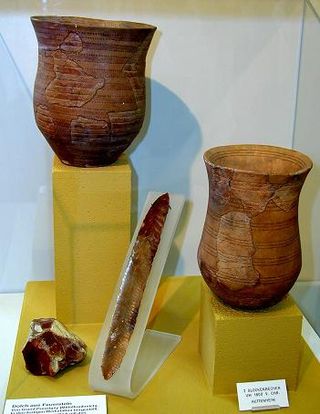Awards
| | This section is empty. You can help by adding to it. (July 2010) |
| |||
|---|---|---|---|
| +... |
The year 1957 in archaeology involved some significant events.
| | This section is empty. You can help by adding to it. (July 2010) |

Vere Gordon Childe was an Australian archaeologist who specialised in the study of European prehistory. He spent most of his life in the United Kingdom, working as an academic for the University of Edinburgh and then the Institute of Archaeology, London. He wrote twenty-six books during his career. Initially an early proponent of culture-historical archaeology, he later became the first exponent of Marxist archaeology in the Western world.

Osbert Guy Stanhope Crawford was a British archaeologist who specialised in the archaeology of prehistoric Britain and Sudan. A keen proponent of aerial archaeology, he spent most of his career as the archaeological officer of the Ordnance Survey (OS) and also wrote a range of books on archaeological subjects.
Below are notable events in archaeology that occurred in 1892.
Below are notable events in archaeology that occurred in 1926.

Culture-historical archaeology is an archaeological theory that emphasises defining historical societies into distinct ethnic and cultural groupings according to their material culture.
An archaeological culture is a recurring assemblage of types of artifacts, buildings and monuments from a specific period and region that may constitute the material culture remains of a particular past human society. The connection between these types is an empirical observation. Their interpretation in terms of ethnic or political groups is based on archaeologists' understanding. However, this is often subject to long-unresolved debates. The concept of the archaeological culture is fundamental to culture-historical archaeology.

Stuart Ernest Piggott, was a British archaeologist, best known for his work on prehistoric Wessex.
In anthropology and archaeology, the urban revolution is the process by which small, kin-based, illiterate agricultural villages were transformed into large, socially complex, urban societies.
The year 1956 in archaeology involved some significant events.
Below are notable events in archaeology that occurred in 1927.
Below are notable events in archaeology that occurred in 1928.
Below are notable events in archaeology that occurred in 1933.
Below are notable events in archaeology that occurred in 1935.
Below are notable events in archaeology that occurred in 1953.

The Royal Commission on the Ancient and Historical Monuments of Scotland (RCAHMS) was an executive non-departmental public body of the Scottish Government that was "sponsored" [financed and with oversight] through Historic Scotland, an executive agency of the Scottish Government.
Below are notable events in archaeology that occurred in 1951.
Rhind Lectures are a series of lectures on archaeological topics. They have been hosted by the Society of Antiquaries of Scotland since 1874. The content of the lectures is usually published in journals or expanded into new works by their authors.

Judith Sheila McKenzie was an Australian archaeologist whose work primarily focused on the architecture of the ancient Middle East. At the time of her death, McKenzie was Associate Professor of Late Antique Egypt and the Holy Land at the University of Oxford and Director of the Manar al-Athar project, an open-access image archive of the Middle East. McKenzie was known in particular for her work on the architecture of Petra and Alexandria, having published lengthy monographs on each.

Manar al-Athar is a photo archive based at the Faculty of Classics at the University of Oxford which aims to provide high-quality open-access images of archaeological sites and buildings. The archive's collection focuses on areas of the Roman Empire which later came under Islamic rule, namely the Levant, North Africa, Turkey, Georgia and Armenia. As of June 2022, the archive holds more than 83,000 unique images. Particular strengths include Late antiquity, as well as the transition from paganism to Christianity and later to Islam.